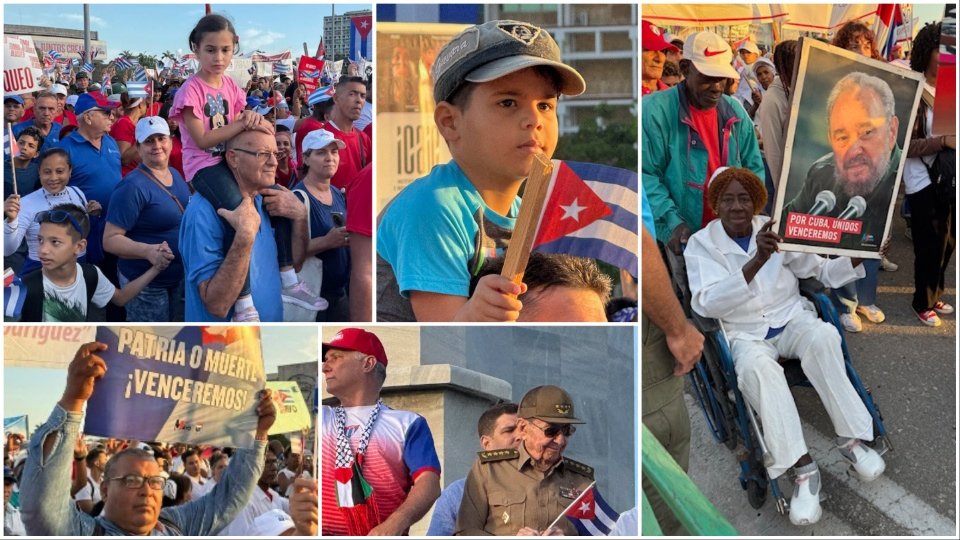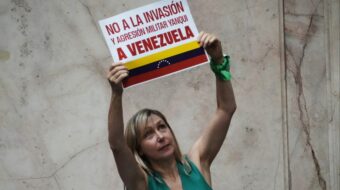
Editor’s Note: Though May Day is now more than a month past, People’s World presents these impressions of the mass May 1 march in Havana from Ike Nahem, a Cuba solidarity activist in the New York / New Jersey area. In this article and photo report, Nahem discusses not only the details of the May Day celebration in Cuba but also its importance as a symbol of Cubans’ determination to preserve their sovereignty, independence, and dignity in the face of an escalating economic assault by the U.S. government. As with all op-ed articles published by People’s World, the views expressed here are those of the author.
HAVANA—May Day 2025 in Havana 2025 was, first and foremost, an overwhelming revolutionary and patriotic mobilization of the Cuban working class and fighting people.
The huge turnout (800,000 in Havana, 5 million+ across the Island), organized under the leadership of the Cuban trade union federation, Central de Trabajadores de Cuba (CTC), was also a big morale boost for the Cuban people.
It registered the clear determination of the population as a whole to turn a corner out of the extended period of intensified (and accumulating) economic difficulties that has plagued them since the onset of the COVID pandemic in 2020.
That health crisis devastated Cuba’s tourism industry, which remains in slow recovery. All of this became a tipping point in the hammering of the Cuban economy over the past several years.
I hope the photos shown here can begin to convey some of the spirit of an amazing day which saw contingents from CTC-organized workplaces and industries, communities, and working-class families from all over the greater Havana area. They were up way early in the morning to board buses converging on Revolution Square.
There were large spirited student contingents from universities, colleges, and schools; soldiers in uniform marching with their families; artists and dancers—it was a real sea of Cuban humanity that stretched for well over a mile.
They had one loud and clear message: Understand this Trump, Rubio, Scott, and all other would-be imperialist aggressors—Cuba lives! Cuba resists! Cuba is not alone!
What stood out was the very youthful presence at May Day, the representation of a new generation of Cuban youth forged during the permanent pressure and aggression from U.S. sanctions. This includes intense imperialist propaganda on social media platforms targeting Cuban youth hoping to stimulate alienation, demoralization, and migration. And of course, there has been mass migration since the deepening of U.S. economic aggression.
All of these assaults aim to choke the dreams of Cuban youth for a better future inside Cuba. So it was particularly inspiring to see the identification of the Cuban youth on May Day with the history, heroes, and continuity of revolutionary, socialist Cuba.
From Trump to Biden to Trump
This is the Cuba that is fighting to get out of the seemingly endless grip of U.S. economic warfare under Trump and Biden over the past nine years. There has been a near-seamless continuity of U.S. anti-Cuba hostility since the reversal of the relative, and ultimately illusory, “normalization” under President Barack Obama.
What the Cuban working class has faced is an accumulating economic crisis of daily difficulties and near-calamitous conditions of shortages, including in medications and life-saving medical equipment. They have likewise experienced intense pressure on an overloaded, very old, and very inefficient electric grid.
These last years have seen cascading crises in production and consumption, currency instability, rising prices, and shortages. On top of these, add the major material devastation of the Saratoga Hotel and Matanzas Oil Storage Facility explosions and the “natural” disasters of hurricanes, flooding, and even earthquakes.
There are some signs and indicators lately of relative alleviation, with important direct foreign assistance, some advances in bilateral trade agreements and capital investment, as well as hopeful prospects that economic space can open up through Cuba’s formal association with the BRICs grouping (which has become more prominent in this era of Trump’s trade wars).
Nevertheless, the overall situation remains harsh and difficult for Cuban working people. And that’s why the May Day mobilizations are so politically powerful.
Targeting Travel to Cuba
Without the anticipated foreign exchange from tourism, the massive capital investments in new hotel construction and other projects have added to budget and financing problems for Cuba. When the tourists don’t come, there’s no money to pay off these infrastructure projects.
The entire Cuban tourism industry has been directly targeted by the U.S. since the relative relaxation of extant travel sanctions under Obama. In the years before the pandemic, the industry had been recovering steadily and impressively.
Travel to Cuba is today, however, is a bureaucratic labyrinth, and not because of any impediments from “communist Cuba,” but rather from the U.S. government. The administration in Washington hassles and tries to intimidate all travelers to Cuba, making visiting the island a de facto political defiance of the U.S. blockade—even for mutually beneficial people-to-people exchanges.
The U.S. government paints Cuba as a “hellhole” even as it aims to smother the right of U.S. citizens to travel and see its reality with our own eyes. Which poses the question: Who is afraid of whom?
U.S. visitors face severe restrictions in hotel and resort accommodations. Even folks on cruise ships face U.S.-instigated obstacles for stopping to enjoy Cuba’s truly rich revolutionary history, its marvelous architectural heritage, its music, museums, and art galleries, as well as its fabulous beaches.
For those who do manage to get in, the devastating impact of the decades-long U.S. economic war are apparent: beautiful structures along the famous Malacon in states of disrepair and collapse; long lines for gasoline; generalized shortages of food, medications and medical supplies; and the total absence from store shelves of so many commodities.
Previously more open, Canadian policy under the unpopular Justin Trudeau government became more aligned with bipartisan U.S. anti-Cuba policy. Perhaps the new Liberal Party government under Mark Carney, in its clashes with arrogant Trumpian bombast insulting Canadian sovereignty, may drop the anti-Cuba posturing of its predecessor, increase trade and travel with the Island, and cease echoing U.S. bellicosity.
Europeans who wish to travel to Cuba face a particularly gratuitous U.S. intimidation tactic under the Electronic System for Travel Authorization (ESTA) regulations. As part of the U.S. visa waiver program, ESTA allows travelers from certain countries to visit the U.S. without a visa. The ability to travel to the U.S. can be put in jeopardy if one has visited Cuba and that fact is registered in the databases and passports of one’s wholly legal travel. Hoops, barriers, repetitive forms, and even visits to a consulate may be among the bureaucratic obstacle-course awaiting international travelers.
Why does the U.S. government impose all these difficulties? In 2016, the ESTA eligibility rules changed as a result of the Terrorist Travel Prevention Act of 2015, which disqualified travelers who reside in or visit any of the countries on the U.S. State Sponsors of Terrorism (SSOT) list. In an outrageous, obscene affront to the truth, Cuba and the SSOT list have been in on-again, off-again relationship since the island was first removed by Obama in 2015.
The latter was in fact a precondition, along with the release of the three remaining Cuban Five political prisoners, for the establishment of diplomatic relations between Washington and Havana in 2015. It was among the steps that many hoped would lead toward actual normalization of relations between the two countries and an end to the U.S. blockade. This, of course, was illusory and short-lived.
The initial limited steps taken by Obama were reversed during the first Trump administration. The Trump changes were shamefully deepened under Biden and the Democratic Party leadership in Congress, even under the conditions of the pandemic. That was the exact opposite of Cuba’s medical internationalist heroics during the COVID years from the Caribbean to Italy to Africa, as Marco Rubio just found out in meetings with Caribbean Community (CARICOM) governments in March 2025.
The Importance of May Day
Over the recent crisis period, there was some diminution of the traditional May Day mobilizations. For the past two years, the Cuban government and CTC have been forced to vastly curtail the traditional festivities due to terrible shortages in gasoline and fuel that made the logistics of organizing transportation impossible.
Smaller mobilizations that were spirited and defiant did take place, but they didn’t match the scale of years past.
The overall situation has been alleviated enough to allow for a revival of the traditional mass Havana march this year. The change of situation was symbolized by the state’s ability to reserve the fuel necessary for the buses to converge near Revolution Square for the celebration.
I should add that for me, as a Marxist, May Day in Havana has always seemed a registration of a society where the working class is in fact the dominant class socially. It’s a chance for the people to showcase the moral values and social relations that are the true legacy of the Cuban Revolution. It’s an expression of the sovereignty which bipartisan Washington has been able to hurt but never defeat.
May Day 2025 showed the Cuban Revolution remains a living revolution.
We hope you appreciated this article. At People’s World, we believe news and information should be free and accessible to all, but we need your help. Our journalism is free of corporate influence and paywalls because we are totally reader-supported. Only you, our readers and supporters, make this possible. If you enjoy reading People’s World and the stories we bring you, please support our work by donating or becoming a monthly sustainer today. Thank you!










